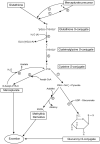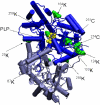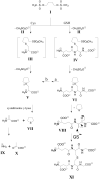Cysteine S-conjugate β-lyases: important roles in the metabolism of naturally occurring sulfur and selenium-containing compounds, xenobiotics and anticancer agents
- PMID: 20306345
- PMCID: PMC2898922
- DOI: 10.1007/s00726-010-0552-0
Cysteine S-conjugate β-lyases: important roles in the metabolism of naturally occurring sulfur and selenium-containing compounds, xenobiotics and anticancer agents
Abstract
Cysteine S-conjugate β-lyases are pyridoxal 5'-phosphate-containing enzymes that catalyze β-elimination reactions with cysteine S-conjugates that possess a good leaving group in the β-position. The end products are aminoacrylate and a sulfur-containing fragment. The aminoacrylate tautomerizes and hydrolyzes to pyruvate and ammonia. The mammalian cysteine S-conjugate β-lyases thus far identified are enzymes involved in amino acid metabolism that catalyze β-lyase reactions as non-physiological side reactions. Most are aminotransferases. In some cases the lyase is inactivated by reaction products. The cysteine S-conjugate β-lyases are of much interest to toxicologists because they play an important key role in the bioactivation (toxication) of halogenated alkenes, some of which are produced on an industrial scale and are environmental contaminants. The cysteine S-conjugate β-lyases have been reviewed in this journal previously (Cooper and Pinto in Amino Acids 30:1-15, 2006). Here, we focus on more recent findings regarding: (1) the identification of enzymes associated with high-M(r) cysteine S-conjugate β-lyases in the cytosolic and mitochondrial fractions of rat liver and kidney; (2) the mechanism of syncatalytic inactivation of rat liver mitochondrial aspartate aminotransferase by the nephrotoxic β-lyase substrate S-(1,1,2,2-tetrafluoroethyl)-L-cysteine (the cysteine S-conjugate of tetrafluoroethylene); (3) toxicant channeling of reactive fragments from the active site of mitochondrial aspartate aminotransferase to susceptible proteins in the mitochondria; (4) the involvement of cysteine S-conjugate β-lyases in the metabolism/bioactivation of drugs and natural products; and (5) the role of cysteine S-conjugate β-lyases in the metabolism of selenocysteine Se-conjugates. This review emphasizes the fact that the cysteine S-conjugate β-lyases are biologically more important than hitherto appreciated.
Figures








Similar articles
-
L-alanine-glyoxylate aminotransferase II of rat kidney and liver mitochondria possesses cysteine S-conjugate beta-lyase activity: a contributing factor to the nephrotoxicity/hepatotoxicity of halogenated alkenes?Biochem J. 2003 Nov 15;376(Pt 1):169-78. doi: 10.1042/BJ20030988. Biochem J. 2003. PMID: 12859250 Free PMC article.
-
Human mitochondrial and cytosolic branched-chain aminotransferases are cysteine S-conjugate beta-lyases, but turnover leads to inactivation.Biochem Pharmacol. 2003 Jan 15;65(2):181-92. doi: 10.1016/s0006-2952(02)01513-7. Biochem Pharmacol. 2003. PMID: 12504794
-
Cysteine S-conjugate beta-lyases.Amino Acids. 2006 Feb;30(1):1-15. doi: 10.1007/s00726-005-0243-4. Epub 2006 Feb 6. Amino Acids. 2006. PMID: 16463021 Review.
-
Toxic, halogenated cysteine S-conjugates and targeting of mitochondrial enzymes of energy metabolism.Biochem Pharmacol. 2002 Aug 15;64(4):553-64. doi: 10.1016/s0006-2952(02)01076-6. Biochem Pharmacol. 2002. PMID: 12167474 Review.
-
Measurement of cysteine S-conjugate β-lyase activity.Curr Protoc Toxicol. 2010 May;Chapter 4:Unit 4.36. doi: 10.1002/0471140856.tx0436s44. Curr Protoc Toxicol. 2010. PMID: 20949433 Free PMC article.
Cited by
-
Metabolic coupling of two small-molecule thiols programs the biosynthesis of lincomycin A.Nature. 2015 Feb 5;518(7537):115-9. doi: 10.1038/nature14137. Epub 2015 Jan 14. Nature. 2015. PMID: 25607359
-
Thiosulfoxide (sulfane) sulfur: new chemistry and new regulatory roles in biology.Molecules. 2014 Aug 21;19(8):12789-813. doi: 10.3390/molecules190812789. Molecules. 2014. PMID: 25153879 Free PMC article. Review.
-
Rid7C, a Member of the YjgF/YER057c/UK114 (Rid) Protein Family, Is a Novel Endoribonuclease That Regulates the Expression of a Specialist RNA Polymerase Involved in Differentiation in Nonomuraea gerenzanensis.J Bacteriol. 2022 Feb 15;204(2):e0046221. doi: 10.1128/JB.00462-21. Epub 2021 Oct 25. J Bacteriol. 2022. PMID: 34694905 Free PMC article.
-
Sulfur- and seleno-containing amino acids.Amino Acids. 2011 Jun;41(1):1-2. doi: 10.1007/s00726-011-0930-2. Amino Acids. 2011. PMID: 21547360 Free PMC article. No abstract available.
-
Crystal structures of RidA, an important enzyme for the prevention of toxic side products.Sci Rep. 2016 Jul 26;6:30494. doi: 10.1038/srep30494. Sci Rep. 2016. PMID: 27458092 Free PMC article.
References
-
- Abraham DG, Cooper AJL. Glutamine transaminase K and cysteine S-conjugate β-lyase activity stains. Anal Biochem. 1991;197:421–427. - PubMed
-
- Abraham DG, Cooper AJL. Cloning and expression of a rat kidney cytosolic glutamine transaminase K that has strong sequence homology to kynurenine-pyruvate aminotransferase. Arch Biochem Biophys. 1996;335:311–320. - PubMed
-
- Abraham DG, Patel PP, Cooper AJL. Isolation from rat kidney of a high molecular weight cysteine S-conjugate β-lyase with activity toward leukotriene E4. J Biol Chem. 1995a;270:180–188. - PubMed
-
- Abraham DG, Thomas RJ, Cooper AJL. Glutamine transaminase K is not a major cysteine S-conjugate β-lyase of rat kidney mitochondria: Evidence that a high-molecular-weight enzyme fulfills this role. Mol Pharmacol. 1995b;48:855–860. - PubMed
-
- Adams B, Lowpetch K, Thorndycroft F, Whyte SM, Young DW. Stereochemistry of reactions of the inhibitor/substrates L- and D-chloroalanine with β-mercaptoethanol catalysed by L-aspartate aminotransferase and D-amino acid aminotransferase respectively. Org Biomol Med. 2005;3:3357–3364. - PubMed
Publication types
MeSH terms
Substances
Grants and funding
LinkOut - more resources
Full Text Sources
Molecular Biology Databases

